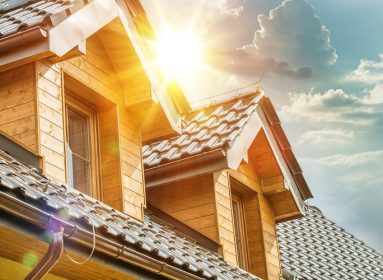
Preventing soil erosion is an important part of protecting your property and the environment. Soil erosion is not just a concern in agriculture or for managing large tracts of undeveloped land. In urban and suburban settings, soil erosion can cause more than just an unsightly landscape for home and property owners.
Should I Be Concerned About Soil Erosion?
The degradation of the top layers of soil makes it difficult for sub-layers to attract or maintain moisture. This causes the soil to contract and expand more quickly, possibly causing damage, such as the shifting and cracking of structural foundations.
Depending on the severity, foundational damage may lead to sagging roofs; leaning or crumbling chimneys; misaligned windows and doors that are difficult to open and close; cracks in exterior siding, interior walls, and ceilings; and warped floors.
What Is Soil Erosion and What Causes It?
Erosion is identified by three specific markers—soil detachment, movement, and deposition—the depositing of the topsoil elsewhere. The impacts of soil erosion include loss of fertile land and in some cases losses of landmass, such as in flooding and landslides. Erosion also increases pollution and sedimentation in waterways, which causes clogging and a decline in aquatic life.
Soil erosion is caused by water, wind, and over-tilling of the land. Heavy downpours, as well as prolonged steady rain, and run-offs originating off site erode topsoil. When water isn’t quickly absorbed, it traps loose soil and carries it away. When the ground is unusually dry, wind can carry loose topsoil for miles. Over-tilling of land degrades the soil quality, contributing to erosion by both water and wind.
Erosion can be a slow process that may go unnoticed for some time, or it can occur quite quickly as the result of extreme weather conditions such as flooding and windstorms. The rate, or ease, at which soil erodes depends in equal parts on the external forces applied and on the soil’s texture, structure, and organic content. Sand and loam resist erosion better than silt and clay soils. Clay doesn’t absorb water quickly. Instead, rain or run-off breaks down the structure and carries the clay away. Silt is easily moved by water and wind.
The incline or slope of land contributes to the rate of erosion as well—the greater the incline and the longer the gradation, the more likely and faster erosion will occur in heavy rain or run-off.
Preventing Soil Erosion and Property Damage
There are four common approaches to preventing unsightly erosion and the damage it causes—adding vegetation, geotextiles, mulch, and retaining walls. Planting grasses, shrubs, and trees is the simplest and most environmentally friendly way to prevent soil degradation.
It takes many years for just one inch of topsoil to form naturally, and only a few years to destroy it and put your property at risk. You can prevent soil erosion, protect your home from damage, and contribute to a healthy environment by adding trees to your landscape. Regardless of the slope of your land or the type and texture of your soil, planting trees helps prevent soil erosion. Trees add to the organic content, improve the structure and stability of the soil, and provide a windbreak.
Roots
Just below the surface of the soil, the root systems of almost all trees mirror the branching system we see above ground, with many primary roots transitioning to smaller secondary roots and finally to an extensive network of feeder roots. Because the roots of the tree remain shallower than the above-ground reach of the trunk and branches, the root systems often reach beyond the drip line of the tree’s canopy.
This spreading root system is one way trees help prevent soil erosion. The roots improve soil drainage by absorbing water, but they also improve the soil structure with the addition of organic matter. The addition of organic matter helps prevent soil compaction and improve drainage.
Foliage
Leaves catch rainwater, directing much of it along stems to branches and down the trunk of the tree, where it will soak into the ground. Also, by interrupting falling rain, tree canopies lessen the force of the raindrops hitting the ground. This causes less disruption of soil that would otherwise be trapped in the rainwater and possibly carried away.
A single tree has less impact, of course, but planting groups of trees, especially with broad leaves and dense foliage, can significantly reduce the force of falling rain and help prevent soil erosion in problem areas.
Windbreaks
Planting trees close together in a single line, or in several rows, creates an effective windbreak to help prevent soil erosion in dry weather. The overlapping canopies reduce the speed and force of the wind, thereby lessening its impact on loose topsoil.
To plant an effective windbreak, choose trees of different species that grow to different heights at maturity. Dense varieties, especially evergreens, will provide the most effective windbreak.
Choosing the Best Trees to Help Prevent Soil Erosion
When choosing deciduous trees to help prevent soil erosion, look for those that will have extensive root systems and broad canopies when fully grown. Depending on varieties, saplings will need several years before reaching maturity. Consider choosing faster-growing varieties to meet your needs sooner. A landscaping professional or arborist, such as those at Mr. Tree, can help you determine which trees will best fit your space and not interfere with foundations or water systems.
For windbreaks, choose trees that provide dense branching and foliage. Evergreens such as Norway and spruce varieties grow quickly, making them popular choices for creating effective windbreaks in single rows.
Although not as effective, Lombardy poplars help reduce wind levels while providing the aesthetic of a deciduous tree. These conical-shaped trees with large, broad leaves can be planted very closely together. For a more effective windbreak, consider planting in two rows or alternating with evergreen selections in a single row.







